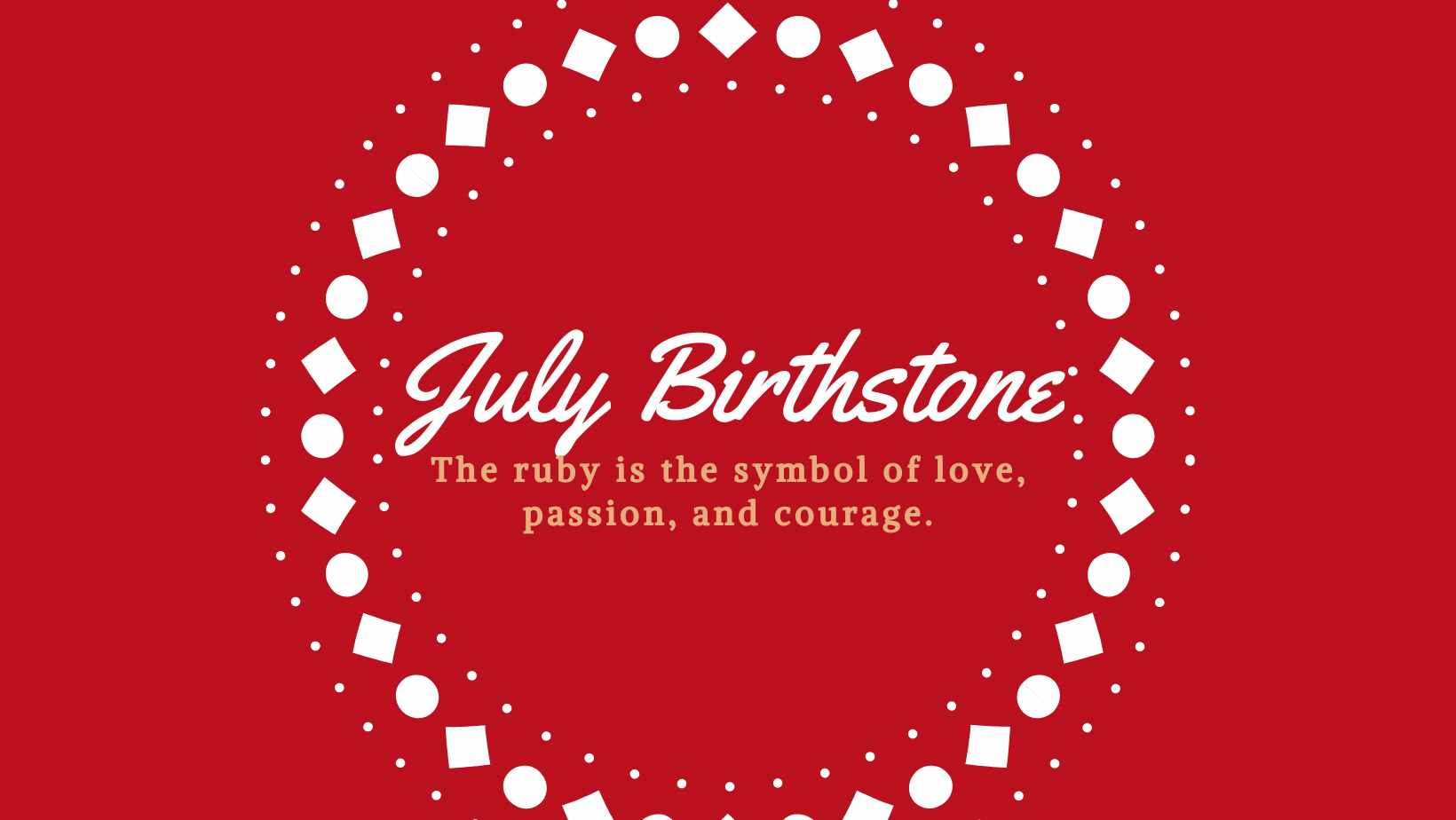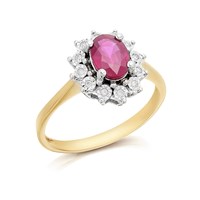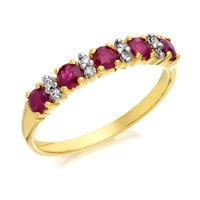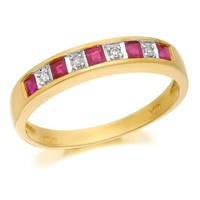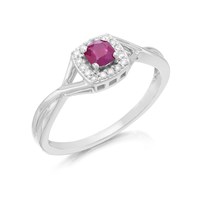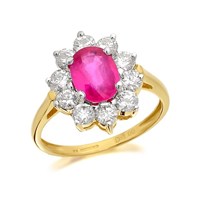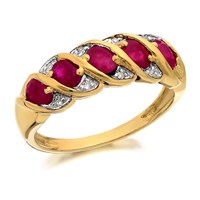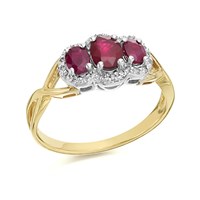The Traditional birthstone for July is the Ruby. Rubies are known for their deep red colour and are a symbol of love, passion, and courage. They are also believed to have healing properties and bring good fortune to those who wear them. Another Gemstone which is associated with July is Onyx.
What is a Ruby?
A ruby is a precious gemstone that is a variety of the mineral corundum. It is one of the four precious gemstones, along with diamond, sapphire, and emerald. Rubies are typically red in colour, ranging from pinkish to deep blood-red. The colour is caused by the presence of chromium in the crystal structure. They are also very durable and resistant to scratching and chipping.
Where Does the word Ruby come from?
The word “ruby” comes from the Latin word “ruber,” which means “red.” The name was given to this gemstone due to its deep red colour. The Latin word “ruber” is related to the Proto-Indo-European root “*reudh-,” which means “red” or “ruddy”.
The word “ruby” has been used to describe this gemstone since the 14th century. It was originally spelled “rubi” or “rubie” and was derived from the Old French word “rubi”. The French word “rubi” was itself derived from the Medieval Latin phrase “rubinus lapis,” which means “red stone”
Where are Rubies found?
Rubies are found all over the world, but there are more significant ruby deposits in certain locations than others. Some of the countries known for producing rubies include Myanmar (formerly Burma), Thailand, Sri Lanka, Tanzania, Madagascar, and Afghanistan. Myanmar is one of the most significant sources of rubies, with the Mogok region producing some of the most valuable rubies in the world. In the United States, rubies can be found in North Carolina, Montana, and Wyoming.
What are the properties of rubies?
- Rubies are a variety of the mineral corundum (aluminium oxide).
- They are typically pinkish-red to blood-red in colour, with the colour caused by the presence of chromium in the crystal structure.
- Rubies have a hardness of 9 on the Mohs scale, making them one of the hardest gemstones.
- They are very durable and resistant to scratching and chipping.
- Rubies are often included, meaning they contain small inclusions, which can affect their clarity and value.
- They are sometimes heat-treated to improve their colour and clarity.
- They are also very durable and resistant to scratching and chipping.
What do rubies symbolise?
Rubies have been prized for centuries for their beauty and rarity. They are often associated with love, passion, and courage. In some cultures, rubies are believed to have healing properties and to bring good fortune to the wearer. Some believe that it can cure inflammatory diseases and soothe anger.
Early cultures believed that rubies held the power of life due to it’s deep red colour the symbol of blood.
History of Rubies
Rubies have a rich and fascinating history that dates back thousands of years. In ancient times, rubies were believed to have magical powers and were worn as a talisman to ward off evil spirits and protect the wearer from harm.
The ancient Hindus believed that rubies were the “king of gems” and represented the sun, and the Burmese believed that rubies were the tears of the gods. In medieval Europe, rubies were associated with royalty and were often used to adorn crowns and other regal objects.
Rubies have also played an important role in religion and mythology. In the Bible, rubies are mentioned as one of the twelve precious stones that adorned the breastplate of the high priest. In Hindu mythology, rubies were believed to have the power to protect the wearer from enemies and to bring prosperity and good fortune.
Today, rubies are still highly valued for their beauty and rarity. They are the birthstone for the month of July and are often given as a gift to celebrate 15th and 40th wedding anniversaries
Folklore of Rubies
Rubies have been associated with various folklore and legends throughout history. In India, it was believed that rubies enabled their owners to live in peace with their enemies. In Burma, warriors wore rubies to make them invincible in battle and even implanted rubies into their skin for protection. In ancient Greece, rubies were believed to have the power to melt wax.
In Hinduism, rubies were regarded as the “king of precious stones” and were associated with the sun and the god of the sun, Surya]. They were also believed to bring good luck and protect the wearer from evil. According to the Harita Smriti, a Hindu religious text, those who worship Krishna with rubies will be reborn as powerful emperors.
In Arabic culture, dreams of rubies were believed to be a sign of impending success and good fortune. In medieval Europe, rubies were associated with royalty and were believed to have the power to ward off evil and illness
How Are Rubies Used?
Rubies are commonly used in jewellery, including rings, necklaces, and earrings. They are also used in watches, cufflinks, and other accessories. Rubies are sometimes used in industrial applications, such as laser technology and microelectronics.
Ruby Gift Ideas
-
 Large Family Ruby Wedding Anniversary Pebbleart Picture£140.00
Large Family Ruby Wedding Anniversary Pebbleart Picture£140.00 -
 Sparkling Memories: Personalised Prosecco Bottle£37.99
Sparkling Memories: Personalised Prosecco Bottle£37.99 -
 9ct Gold Ruby And Diamond Cluster Ring£399.00
9ct Gold Ruby And Diamond Cluster Ring£399.00 -
 9ct Gold Ruby And Diamond Half Eternity Ring£299.00
9ct Gold Ruby And Diamond Half Eternity Ring£299.00 -
 9ct Gold Diamond And Ruby Half Eternity Ring£225.00
9ct Gold Diamond And Ruby Half Eternity Ring£225.00 -
 9ct White Gold Cushion Ruby And Diamond Cluster Ring£299.00
9ct White Gold Cushion Ruby And Diamond Cluster Ring£299.00 -
 9ct Gold Ruby And 1 Carat Diamond Cluster Ring£1,499.00
9ct Gold Ruby And 1 Carat Diamond Cluster Ring£1,499.00 -
 9ct Gold Ruby And Diamond Band Ring£399.00
9ct Gold Ruby And Diamond Band Ring£399.00 -
 9ct Gold Two Colour Ruby And Diamond Cluster Ring£399.00
9ct Gold Two Colour Ruby And Diamond Cluster Ring£399.00
Ruby jewellery: Ruby is a popular gemstone for jewellery, and there are many options to choose from, including rings, necklaces, bracelets, and earrings. You can find ruby jewellery in a range of styles and price points, from simple and elegant to bold and statement-making.
Ruby home décor: If you’re looking for a unique gift, consider ruby-themed home décor items, such as ruby-coloured glassware, vases, or picture frames.
Ruby-themed accessories: You can find a variety of accessories that feature ruby accents, such as watches, handbags, and scarves. These items are a great way to add a pop of colour to any outfit.
Ruby-themed gifts for a 40th anniversary: The ruby is the traditional gift for a 40th wedding anniversary. Consider a ruby-themed gift, such as a piece of jewellery or a ruby-coloured vase, to celebrate this milestone occasion.
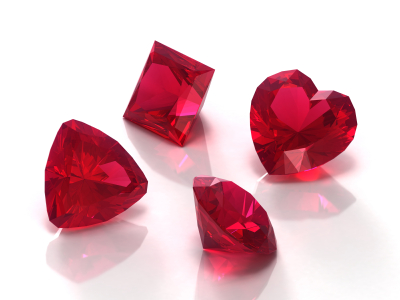
What To Look For When Choosing a Ruby
When choosing a ruby, there are several factors to consider to ensure you get a high-quality gemstone. Here are some of the things to look for:
Colour: The colour of a ruby is the most important factor in determining its value. Look for a ruby with a rich, vibrant red colour, with no hints of brown or orange. The most valuable rubies have a pure red colour, with a slight bluish or purplish tint.
Clarity: Like all gemstones, rubies can have inclusions or blemishes that affect their clarity. Look for a ruby with minimal inclusions, especially those that are visible to the naked eye. However, some inclusions can give a ruby a unique character and are acceptable as long as they do not affect the overall beauty of the stone.
Cut: The cut of a ruby can affect its brilliance and overall appearance. Look for a ruby with a well-proportioned cut that maximizes its colour and minimizes its inclusions. A well-cut ruby will have a symmetrical shape, good proportions, and excellent polish.
Carat weight: Rubies come in a range of sizes, and larger stones are generally more valuable than smaller ones. However, the value of a ruby is determined by a combination of its colour, clarity, and carat weight, so a smaller but higher-quality ruby may be more valuable than a larger but lower-quality one.
Origin: The origin of a ruby can affect its value and desirability. Rubies from certain locations, such as Burma (Myanmar) and Mozambique, are highly prized for their colour and clarity and are more valuable than rubies from other locations.
Keep in mind that each ruby is unique, and the factors that determine its value and beauty can vary depending on the stone. It’s always a good idea to consult with a reputable gemmologist or jeweller when selecting a ruby to ensure you get a high-quality gemstone that meets your needs and budget.
Caring For Ruby Jewellery
Here are some tips for caring for your ruby jewellery:
Store your ruby jewellery separately: To prevent scratches and damage, store your ruby jewellery separately from other jewellery in a soft pouch or lined jewellery box.
Avoid exposure to chemicals: Rubies can be damaged by exposure to chemicals such as chlorine, bleach, and other household cleaning products. Avoid wearing your ruby jewellery while cleaning or swimming in chlorinated water.
Clean your ruby jewellery regularly: To keep your ruby jewellery looking its best, clean it regularly with a soft cloth and mild soap and water. Avoid using harsh chemicals or ultrasonic cleaners, as these can damage the stone or setting.
Handle your ruby jewellery with care: Rubies are a relatively hard gemstone, but they can still be chipped or scratched if handled roughly. Be careful when wearing and handling your ruby jewellery, and avoid exposing it to extreme temperatures or sudden changes in temperature.
Conclusion
In conclusion, rubies are a beautiful and fascinating gemstone with a rich history dating back thousands of years. They are highly valued for their beauty, rarity, and durability, and have been associated with royalty, religion, and mythology throughout history.
Whether you’re looking for a birthstone gift, a special anniversary present, or just a beautiful piece of jewellery to treasure, rubies are a stunning and timeless choice that will never go out of style.
I hope this blog has provided you with some useful information about rubies and their history, and has inspired you to appreciate the beauty and value of these precious gemstones.

